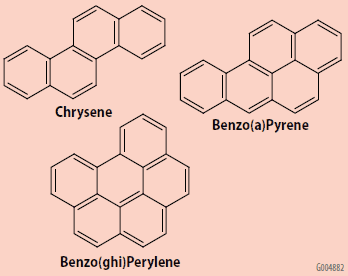Extraction and Analysis of PAHs in Olive Oil using Molecularly Imprinted Polymer SPE and GC-MS
Olga Shimelis, Katherine Stenerson, Daniel VitkuskeSanja Beyowich1, Brian Boyd1
MIP Technologies AB, Scheelevagen 22, 220 07 Lund, Sweden
Reporter US Volume 27.5
Introduction
Polycyclic Aromatic Hydrocarbons (PAHs) are environmental carcinogenic compounds that can be present in food from many different sources – either naturally or from pollution, packaging, or food preparation procedures such as heating and grilling (1). PAHs consist of fused aromatic rings. Due to the lipophilic nature of PAHs, fats and oils can be especially susceptible to PAH contamination. Previously, levels as high as 26 μg/kg of PAHs were found in virgin olive oils (2). The structures of representative PAHs are shown in Figure 1. In 2005 the European Union Commission Regulation (EC) No 208/2005 set maximum limits for PAHs in food. For oils and fats intended for direct human consumption, the maximum residue limit as benzo(a)pyrene on wet weight is 2 μg/kg (3). Edible oils are particularly difficult to analyze, because the oil matrix overloads HPLC columns.

Figure 1. Representative Structures of PAHs
SPE is one of the most popular methods for extraction of PAHs from oil. We have evaluated the recently developed molecularly imprinted polymer (SupelMIP® PAHs) for the extraction of PAHs from olive oil and subsequent analysis by GC-MS.
Molecularly Imprinted Polymers
Molecularly imprinted polymers are a class of highly cross-linked polymer-based molecular recognition elements engineered to bind one specific target compound or a class of structurally related compounds with high selectivity. The MIP material is designed with cavities that are sterically and chemically complementary to the target analyte(s). As a result, multiple interactions (e.g. hydrogen bonding, ionic, van der Waals, hydrophobic) can take place between the MIP cavity and the analyte.
Extraction and Analysis of PAHs in Olive Oil
A standard mix of PAH compounds was prepared in methylene chloride and contained benzo(a)anthracene, chrysene, benzo(b)fluoranthene, benzo(k)fluoranthene, benzo(a)pyrene, indeno(123-cd)pyrene, dibenzo(ah) anthracene and benzo(ghi)perylene.
Store-purchased olive oil was spiked with PAHs in duplicate at the level of 2 μg/kg. Chrysene-d12 was spiked as the internal standard at the level of 20 μg/kg.
0.5 g of spiked and blank oil sample was mixed with 0.5 mL cyclohexane and was extracted using the SupelMIP SPE procedure described in Table 1 and analyzed via GC-MS conditions detailed in Table 2.
PAH background contamination was found in the blank olive oil sample. The most abundant compound was found to be chrysene at almost 10 μg/kg. This is consistent with previous studies that found light (2-4 rings) PAHs to be more predominant in the oils (2).
Using the SupelMIP SPE PAH approach, an average recovery of 82% was observed. All compounds contained at least 4 fused aromatic rings.
Conclusions
In this article we described the extraction of PAHs from olive oil using SupelMIP SPE PAHs and analysis by GC-MS. The extraction procedure is very simple and includes only a 5-step SPE cleanup process. The procedure is amenable to larger PAH molecules. Extraction of smaller PAH molecules (2-3 rings) may be possible, however, lower recoveries may be expected.
References
Para continuar lendo, faça login ou crie uma conta.
Ainda não tem uma conta?